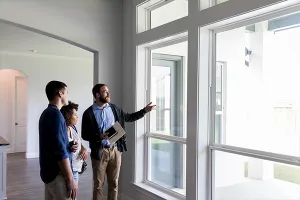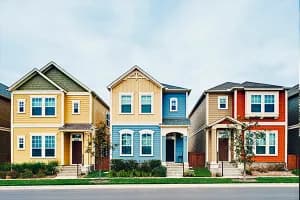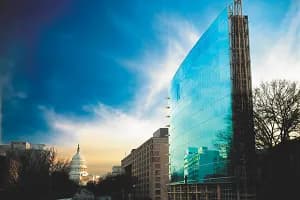
Architects, designers and wellness experts are curating wellness spaces for individual and group activities in large part because of demand for these kinds of features. Certain demographics such as Gen Zers and Millennials show extra interest, according to McKinsey’s latest wellness report, which pegged the 2024 global market at $1.8 trillion. Real estate professionals will find more and more of their customers seek homes with wellness-specific features or examples of how to add wellness into their lives.
Here are ways to share with homeowners how wellness can become part of their residential surroundings and lives:
Use Natural Elements in the Home
To fashion the right backdrop and mood for a wellness space, more professionals incorporate the tenets of biophilic design, which connects users to nature through views and access to the outdoors and choices of natural materials. Designer Alena Capra, CMKBD, who works with Armina Stone, a large importer and fabricator of natural stone, suggests using natural stone to surface countertops, walls and floors. “Whether it's a stone accent wall, cladding on shower walls, countertops in a spa or primary bath or even counters in a home gym, the ability to bring in a bit of natural stone for that connection with nature is something we are seeing more of in residential and commercial interiors,” she says. Among popular choices are marble, quartzite and even semi-precious stone in serene colors.
Another option is to paint walls and ceilings in a limewash, a breathable, natural material that allows moisture to evaporate and prevent mold and mildew growth, says real estate salesperson Delaney Fox of Keller Williams Luxury International SVSI in Ketchum, Idaho. Some also like to install a kill switch to pare exposure to magnetic electromagnetic fields (EMF), Fox says.
Make Relaxation Intentional
Morgante Wilson Architects sees more clients look to the built environment to improve their mental and physical well-being, whether it’s installing spaces that maximize connectivity with others or locations with direct access to natural elements like water. “Many want a spa experience to help them decompress,” says firm associate architectural designer Kevin Thayer. More people are installing wet rooms that include both a shower and tub to save space and make rinsing off after a bath easier. These spaces require less square footage than a traditional primary bathroom does, a trend also noted by Houzz.
The home gym is still popular, especially with the rise of online fitness classes post-pandemic. Thayer says homeowners want functionality and style, which his firm elevates through Scandinavian-style hardwood flooring rather than rubber matting.
For a bigger investment and new twist, some install cold plunge pools and saunas indoors or outdoors, Fox says. The therapeutic benefit is that getting into the cold water can reduce inflammation and it’s said to be great for longevity, regeneration and clarity, she says.
Still another new option is what designer Sharon McCormick, Sharon McCormick Design, Allied AIA-CT, terms a “Zen Den,” a room designed for Zen meditation or Nia—a combination of holistic modern dance, martial arts and mindfulness workout. “Mindfulness is a hot topic as the general public becomes more informed of the practice and its positive effect on mind, body and soul and to ease anxiety and anger,” McCormick says.
Communal Wellness in Multifamily
Developers of condominium and apartment buildings are adding choices as wellness trends extend beyond pilates and yoga and more buildings hire wellness experts to launch experiences. Salesperson Claire O’Connor of O’Connor Estates sees more sauna and cold plunge pools in the luxury mix.
Curated Options
Related Group, a multifamily developer, incorporates more saunas but also newer features such as salt spa rooms to improve breathing and promote relaxation. The company’s St. Regis Residences in Miami also includes a relaxation area and juice bar. At its Rivage Bal Harbour in Miami Beach, there are hammam spa amenities, which use hot steam to encourage a deep and invigorating cleanse.
At 200 Amsterdam in New York City, SJP Properties designed amenities to inspire creativity and relaxation. Residents can enjoy a soundproof rehearsal room, a children’s playroom featuring a performance stage and costume area, luxurious rain showers and golf simulators with championship courses for an immersive experience.
Immersed in Nature
The wellness trend has moved outdoors where setting aside land for green parks and trails encourages healthfulness amid fresh air. The town of Tower at Trilith in Fayetteville, Ga., planned its sustainable environment with a large central park and 19 pocket parks so that homes face or are within one block of green space. There are also 15 miles of pedestrian pathways throughout the planned town, says Rob Parker, president. Many homes were also designed with a small footprint—down to 500 square feet for its micro models—for easy maintenance and the conservation of land for shared purposes.
Developer Lendlease took a similar step when it developed outdoor space at two downtown Chicago buildings, which nearby residents and workers can also use. As part of its Cirrus development, a 350-unit condominium tower on Lake Michigan, the firm designed Cascade Park, an adjacent public space with series of switchbacks that provide lakefront access, transforming what was once a 50-foot elevation change into a safe, accessible connection to the lakefront and its adjacent trail. Cirrus also features The Conservatory, a 900-square-foot biophilic space with raised garden beds, vegetation and seating nooks.
Another example, located in Chicago’s South Loop, is The Reed at Southbank. The 440-unit residential tower features a central lawn, stone amphitheater and native plantings. Meandering walkways link to a new riverwalk with viewing platforms and seating, providing settings that support physical and mental well-being and community interaction.
Focus on Indoor Air Quality
More residential builders and homeowners are focused on HVAC systems and technologies that help curtail air leakage and perform more sustainably such as Aeroseal. More also build to higher green standards, through a leading sustainable certification program known as BREEAM. Health and well-being feature strongly in the certification, which addresses and rewards building features that improve indoor air quality such as ventilation systems designed to reduce pollutant exposure, use of low-emission materials and monitor systems that track and maintain healthy air levels.
It also addresses energy efficiency, which is linked to thermal comfort, and resilience which helps homeowners and residents prepare for natural disasters and ensures that a building continues to provide a healthy home.
As wellness continues to shape home design, both buyers and builders are prioritizing features that promote health, relaxation and sustainability. From natural materials to curated wellness spaces, these elements not only enhance daily living but also add long-term value. By integrating thoughtful design choices, homeowners can create environments that support well-being, efficiency, and a deeper connection to their surroundings.









